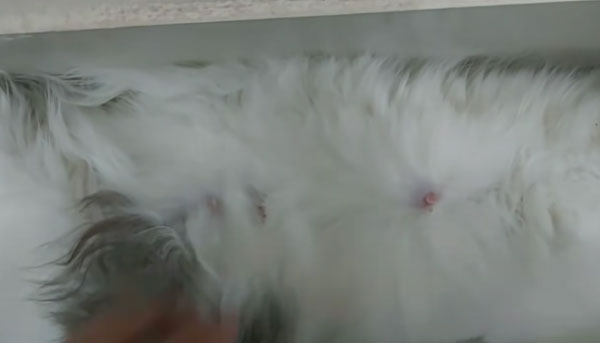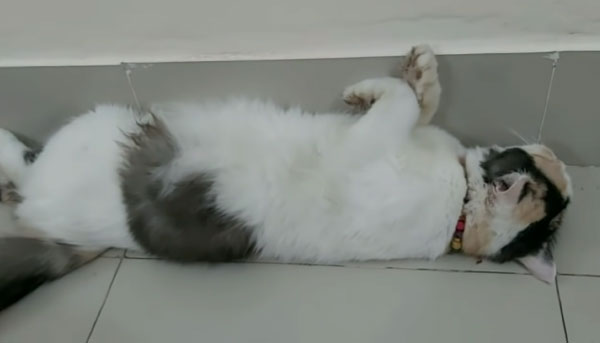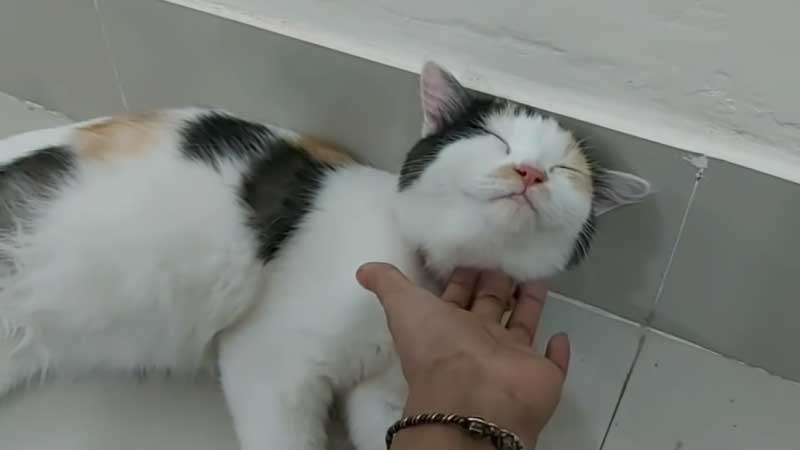Imagine you’re walking down your neighborhood street when you spot a stray cat with a rounded belly, sauntering past with the grace of nature itself. Your heart twitches a bit as you realize: she’s not just any stray cat—she’s a pregnant stray cat, soon to be a mother, navigating the urban wilderness alone. Helping a pregnant stray cat might seem like a difficult task, but it’s a deeply rewarding journey that can make a significant difference in the lives of the mother and her future kittens.
Now the question is: how to help a pregnant stray cat? To quickly assist a pregnant stray cat, start by providing a safe, quiet space for her to rest, along with consistent access to food and water. Consult with a veterinarian for a health check-up to ensure both her well-being and that of her unborn kittens.
If you want to know more in detail, just continue reading for further instructions. We have written in detail about this topic.
At First: How to Confirm Pregnancy in a Stray Cat

If you want to know for sure that a stray cat is pregnant, there are a few things you can look for. While a visit to the veterinarian is the most reliable method for confirmation, there are various indicators you can look out for before seeking professional help.
Initially, you might notice physical changes in the cat. Her belly will gradually swell as the kittens grow, but this is more apparent in the later stages of pregnancy. Before the belly becomes noticeably larger, you may see that her nipples are enlarging and turning a rosier color, a phenomenon known as “pinking up,” which occurs around the third week of pregnancy.
Behavioral changes are also common. Pregnant stray cats often seek out more secure and quiet places, indicating they are looking for a safe spot to give birth. Their appetite might increase as they try to consume more calories to support the growing kittens.
In addition to these signs, a pregnant cat may exhibit nesting behaviors a few days before delivery. She might start gathering soft materials or seeking out secluded spots as she prepares for the arrival of her kittens.
However, it’s crucial to approach a stray cat carefully, especially if you’re trying to determine if she’s pregnant. Stray cats can be wary of humans, and pregnant cats may be even more sensitive. If you can safely get close enough to observe these signs without stressing the cat, do so. Otherwise, consider seeking assistance from a local animal rescue organization or a veterinarian for a more definitive assessment.
For the most accurate confirmation of pregnancy, a veterinarian can perform an ultrasound, palpate the abdomen to feel the kittens (usually after the 17th to 25th day of pregnancy), or use X-rays in the later stages of pregnancy to determine the number of kittens. These methods not only confirm pregnancy but also help assess the health of the mother and her unborn kittens, ensuring that any necessary care or intervention is provided in a timely manner.
How to Help a Pregnant Stray Cat? Nutritional Needs of a Pregnant Stray Cat
| Nutrient | Requirement | Notes |
|---|---|---|
| Protein | High (Increase by up to 50% over normal adult requirements) | Supports fetal growth, milk production, and the health of the mother. |
| Fats | Moderate to High (Essential fatty acids are crucial) | Supports energy needs and fetal development. |
| Calcium | 1.0 to 1.8 g/kg body weight per day | Important for bone development in fetuses. |
| Phosphorus | 0.8 to 1.6 g/kg body weight per day | Works with calcium to ensure proper bone development. |
| Magnesium | Slightly increased | Important for enzyme function. |
| Vitamin A | Increased (Consult vet for exact dosage) | Critical for preventing birth defects; too much can be toxic. |
| Vitamin D | Increased (Consult vet for exact dosage) | Important for calcium absorption and bone development. |
| Taurine | Essential (400 mg/kg of food) | Critical for heart and eye health. |
| Water | Always accessible, clean water | Hydration is crucial for health and milk production. |
How to Create a Safe Nesting Area for Pregnant Feral Cat

It is critical to provide a pregnant stray cat with a secure nesting area so she can give birth in comfort and safety. Here’s how you can set up a welcoming space:
Choose a Quiet Location
Select a quiet, low-traffic area of your home or a sheltered outdoor space. The location should be away from loud noises and disturbances to provide a calm environment for the cat.
Use a Spacious Container
A large cardboard box, a laundry basket, or a pet carrier can serve as the base of the nesting area. Ensure it’s spacious enough for the cat to move around comfortably and accommodate her future kittens.
Ensure Easy Access
The sides of the container should be low enough for the cat to easily enter and exit, but high enough to keep the kittens contained once they arrive. If using a box, you might cut one side to create a low entry point.
Provide Soft Bedding
Line the container with soft, clean bedding such as towels, blankets, or fleece. These materials will keep the cat and her kittens warm and comfortable. Avoid using materials that fray easily or can be ingested.
Add Warmth
If the area is particularly cool, consider adding a safe heating element, like a heated pet bed or a hot water bottle wrapped in a towel. Ensure any heat source is not too hot and is placed in a manner that allows the cat to move away from it if she becomes too warm.
Keep It Clean
Maintain cleanliness around the nesting area by regularly replacing soiled bedding with fresh, clean materials. This helps prevent infections and keeps the environment healthy for the mother and her kittens.
Provide Privacy
Cats prefer privacy during birth and the initial nursing period. If possible, place the nesting area in a secluded part of your home or use a blanket to create a curtain around an outdoor shelter. Ensure the cat can still easily see out of the area and doesn’t feel trapped.
Access to Food, Water, and Litter
Place food, fresh water, and a litter box near the nesting area, but not so close that they contaminate the bedding. This allows the mother to care for her needs without straying too far from her kittens.
Minimize Disturbance
Once the cat begins to use the nesting area, try to disturb her as little as possible. Allow her to acclimate and feel secure in her new space, checking on her and her kittens quietly and infrequently.
Monitor Health
Keep an eye on the mother and her kittens for any signs of distress or health issues. Consult with a veterinarian if you notice anything concerning.
What to Do with a Pregnant Feral Cat: Timeline for Vet Visits and Vaccinations

| Stage | Recommended Actions | Vaccinations |
|---|---|---|
| Confirmation of Pregnancy | Veterinary visit for pregnancy confirmation, initial health check-up, and nutritional advice. | None specific to pregnancy |
| Mid-Pregnancy | Follow-up veterinary visit for health monitoring and nutritional adjustments. | None specific to pregnancy |
| Pre-Birth | Final pre-birth check-up to assess health and prepare for delivery, discuss birthing complications. | None specific to pregnancy |
| Post-Birth (0-8 weeks) | Initial health check for mother and first vaccinations for kittens, deworming. | First round of core vaccinations for kittens (FVRCP and possibly FeLV depending on risk) |
| Kittens (8-12 weeks) | Second round of vaccinations for kittens, continued health monitoring of mother. | Second round of FVRCP, FeLV (if started and at risk) |
| Kittens (12+ weeks) | Final round of kitten vaccinations; spay/neuter considerations for mother and kittens. | Rabies vaccination (as per local regulations), final FVRCP |
FAQs
How can I tell if a stray cat is pregnant?
A pregnant stray cat may show several signs indicating her condition, such as a noticeable increase in belly size, enlarged and pinkish nipples (a condition known as “pinking up”), increased appetite, and nesting behavior. Observing these signs from a distance can help you identify a pregnant stray cat.
What should I do if I find a pregnant stray cat?
If you find a pregnant stray cat, try to provide a safe, quiet space for her to feel secure. Offer food and fresh water regularly, and contact a veterinarian for guidance on how to proceed, especially regarding health check-ups and preparing for the birth.
How can I create a safe nesting area for a pregnant stray cat?
Create a nesting area by choosing a quiet, secluded spot. Use a large box or a similar container lined with soft, clean bedding. Ensure the area is easily accessible to the cat but offers privacy and warmth. Keep food, water, and a litter box nearby but not too close to keep the area clean.
What are the nutritional needs of a pregnant stray cat?
A pregnant stray cat needs a diet high in protein, fats, vitamins, and minerals to support her kittens’ growth and maintain her health. Feed her kitten food, which is richer in essential nutrients, and ensure she has constant access to clean, fresh water.
How often should a pregnant stray cat see a vet?
Ideally, a pregnant stray cat should see a vet as soon as you notice she is pregnant for an initial check-up. Midway through her pregnancy, a follow-up visit can help monitor her health and the kittens’ development. A pre-birth check-up can also help prepare for the delivery.
What should I do once the kittens are born?
Once the kittens are born, minimize handling to reduce stress on the mother and the risk of rejection. Ensure that the nesting area remains clean and that the mother has plenty of food and water. The kittens and the mother should visit a vet within a few days after birth for health checks and vaccinations.
When can the kittens be rehomed?
Kittens should stay with their mother until they are at least 8-12 weeks old. During this time, they will be weaned and begin eating solid food. They should also receive their initial vaccinations before being rehomed to ensure they are as healthy as possible.
Is it necessary to spay the mother cat?
Yes, it is highly recommended to spay the mother cat to prevent future unwanted litters and reduce her risk of certain health issues. Spaying can be discussed with your vet, who can advise on the appropriate timing based on the mother’s health and her recovery post-birth.
Final Verdict
Caring for a pregnant stray cat presents a unique set of challenges and responsibilities, but it also offers a deeply rewarding opportunity to make a positive impact on the lives of the cat and her future kittens. By understanding the signs of pregnancy, providing a safe and nurturing environment, ensuring proper nutrition, and seeking veterinary care, you can support the health and well-being of both the mother cat and her offspring.
Creating a safe nesting area is crucial for the comfort and security of the pregnant cat as she prepares for birth. Regular veterinary visits are essential to monitor the mother’s health and the kittens’ development, ensuring any potential issues are addressed promptly. Post-birth, the focus shifts to maintaining the health of the mother and kittens, including vaccinations, deworming, and eventually spaying or neutering to prevent future stray populations.



